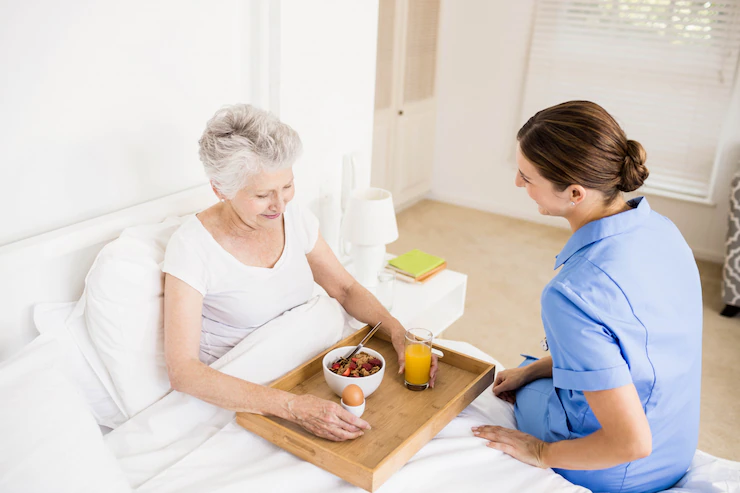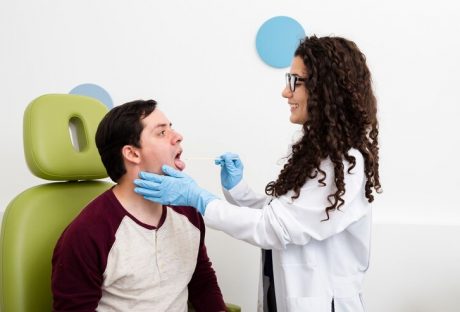Any Adult Gerontology Nurse Practitioner (AGNP), or individual considering moving into this booming area, will probably be aware that it involves more than supporting patients through short term illnesses or meeting their needs in a hospital or nursing home.
As a rule, the older a patient gets, the more likely they are to experience chronic health complications which interfere with their day-to-day tasks. For much of history, such patients were written off, encouraged to take to their beds and be supported entirely by others, doing very little. They often didn’t live very long. But all that changed on account of one remarkable nurse, Dorothea Orem, whose legacy continues to shape the nursing profession today. This article examines her groundbreaking self-care deficit theory and looks at how AGNPs might use it for their nursing career.
Dorothea Orem
Dorothea Orem was born in Baltimore in 1914 and studied nursing in the late 1930s. This was a time when nursing schools were still a new phenomenon and there was a lot of experimental thinking in the nascent profession. Though she spent time on the wards as a staff nurse, she also worked as an administrator and consultant over the course of her career, spending her later years focusing on theory.
A naturally focused and attentive person, she soon began recording observations about the patients she worked with, leading to her self-care deficit theory of nursing, for which she strongly advocated for her entire life. It was theory which, in its early years, transformed the way nurses thought about patients and their duties. It laid the foundations for nursing today.
Universal Self-Care Requisites
Orem’s theory recognizes eight universal self-care requisites, or SCRs. Here, universal refers to things every human needs, regardless of circumstance. Air is needed for respiration. Water is needed to maintain a healthy level of hydration. Food is needed to maintain healthy energy levels and prevent starvation. Elimination or toileting, a polite way of referring to the expulsion of urine and feces from the body, is required too.
In addition to these four things, Orem posits that every patient needs a balance of physical activity and rest. Everyone needs social interaction, but also some alone time. People need to manage their lives to avoid or remove hazards, and, finally, they need to promote normality. This means that they need to achieve and maintain a way of living and relating to the world which is normal for them as individuals and does not involve psychosis.
Health Deviation Self-Care Requisites
When patients are recovering from injury or illness, or living with a chronic illness or disability, they can be described as experiencing a health deviation. This is not pejorative – it simply establishes that they differ from the norm. Health deviations are more common in older demographics, as they have additional self-care requisites.
These requisites include following doctors’ instructions (taking medicine on time), identifying problems caused by their conditions and attending to them effectively (sitting down until a dizzy spell passes), and knowing when and how to seek help from a caregiver or healthcare professional.
It is also important that these patients can understand and accept that their bodies have changed and can adjust psychologically to cope with it.
What Is A Self-Care Deficit?
A self-care deficit occurs when people are no longer able to carry out basic tasks. This can be because a disability makes them physically impossible to perform, or a number of other reasons. For example, some people get so overwhelmed by the way their bodies have changed that they stop trying to live. This doesn’t mean that they don’t deserve sympathy – it is an understandable response to an extreme situation – but it might mean that there is potential for improvement.
For some people, self-care deficits are permanent or are likely to worsen due to progressive illnesses. For others, however, they can be temporary, even in extreme old age. Self-care deficits stemming from a broken arm, for example, will normally dissipate after the arm heals, but this is less likely if the patient has learned to feel helpless in the meantime.
Assessment, Diagnosis, And Implementation
When using Orem’s theory, nurses have three steps to work through. The first is undertaken during the initial assessment of a new patient and involves identifying any self-care deficits. These are not always obvious from looking at a patient and the process may require gentle but persistent questioning. Some people may be embarrassed and hesitant to talk if they are unable to care for themselves.
The second involves full diagnosis of the deficits, including establishing causes. The third step is to draw up a treatment plan based on these diagnoses. In her work, Orem stressed the importance of recognizing that every patient is a unique individual, so there is no one-size-fits-all approach to this type of planning. In each case, AGNPs will need to work with the patient to establish the most effective way forward.
Five Ways Nurses Can Help
There are five strategies nurses can use to address self-care deficits when establishing patient care plans:
- For the most severely incapacitated patients, it may be necessary to perform actions on their behalf, such as washing or dressing them.
- Patients struggling mentally or who lack confidence can be guided through actions, ideally to the point of independence.
- Patients can be taught new ways of approaching day to day tasks which make them easier to accomplish, such as taking a break to have a shower in the afternoon if it is too hard to find the energy at other times.
- AGNPs can focus on the patient’s environment, making it easier for them to carry out self-care activities, such as suggesting kitchen gadgets to reduce the physical effort involved in preparing meals.
- Finally, AGNPs can train a family caregiver to provide appropriate support.
These five strategies involve numerous actions, skills, and tools that nurses can use. Patients may need particular assistance with the following tasks.
Helping With Eating
Patients should always be encouraged to do as much for themselves as is reasonably possible. When it comes to eating, nurses should start with encouragement. Many older people lose their appetite and don’t feel motivated to eat, especially when it requires effort. So, an AGNP can point out that they have more energy when they manage to eat regular meals.
If the patient can get food to their mouth by themselves, nurses should resist the temptation to assist, even if they sometimes drop the food. Instead, nurses can reassure them that this is not uncommon and all they need to do is take a little more time. Nurses should also be alert to the possibility of choking issues and arrange X-rays if concerned. If some food proves difficult to eat, they can discuss the possibility of dietary adjustments.
Helping With Toileting
Nurses should reassure patients that, awkward as they may feel, there is nothing to be embarrassed about. The nurse must ensure they can transfer on and off the toilet safely and consider options like raising the height of the seat or installing grab. If there is a risk of falling, AGNPs may suggest bedpans for use when no caregiver is present. If adult diapers are needed, nurses should ensure that patients know how and when to change them (even if they are not soiled) and how to protect their skin against rashes or bruises caused by wearing them. Finally, nurses can also discuss medical options for softening stools or speeding up or slowing down digestive transit.
Helping With Dressing And Grooming
A balance must be struck between helping patients be more independent in dressing and grooming themselves and enabling them to maintain a style or standard of appearance that is natural for them. Some older men prefer to be clean shaven but end up growing beards because it is easier to trim a beard than it is to shave safely and neatly, for example. Some clothing options can be easier to get into than others, depending on a patient’s particular mobility difficulties. Simple devices such as a stick with a hook on the end can make adjusting the back of a garment or doing up a zip much easier. Nurses should pay particular attention to footwear to make sure patients can stand or walk safely.
Reducing Hazards
Whether a nurse is helping a patient to move around and complete self-care tasks in a hospital ward, a care home, or their own home, they must always pay attention to hazard prevention. Hazards can include mess, a layout created without regard for disability, or other people or pets moving around. Nurses can start by ensuring that the patient is aware of the risks and can recognize dangerous situations.
They should discuss simple measures like installing handrails or changing routines to make it easier to keep the area tidy. Nurses can also ensure that the patient can summon help if something goes wrong, by persuading them to install an alarm system or carry a charged mobile phone at all times, for example.
Care With Communication
Often, older patients who have self-care deficits also have difficulty with communication, whether due to physical or cognitive disability. Depending on their lifestyle in recent years, they may also be unfamiliar with modern technologies, but shy about admitting this. It is important for nurses to make sure that when they are addressing issues around essential needs, the patient understand them properly and vice versa.
It can be helpful to use pictures in communication, which are often available in support materials. When meeting a patient in the place they are going to be living, the nurse and patient can explore it together (in stages, if necessary) so both parties can directly identify issues.
Seeing Each Patient As An Individual
An essential tenet of Orem’s theory is that patients must be treated as individuals. This increases the chance that they will stick to treatment plans, as well as directly improving their psychological wellbeing.
Any nurse that’s interested in Orem’s theory and is considering joining this field will be looking into gerontology nurse practitioner programs online. The best courses place a lot of emphasis on adaptability and on learning how to manage different types of patients in different environments. The program at the University of Indianapolis, for example, encourages students to develop the patience and listening skills essential to getting to know patients and making them a part of the process. This communication and relationship building is essential to developing plans which will really benefit patients over the long term. The course at the University of Indianapolis is an eight-semester program designed for working nurses, involving part-time study and an intensive clinical placement.
The Nursing Profession Continues To Benefit
Thanks to Orem and her self-care deficit theory, patients are no longer left to waste away as they begin to struggle with old age. Generations of nurses who have practiced this theory have observed that, even in later life, patients can often improve and regain their self- care abilities with the right support. Advances in assistive technologies continue to make this even easier.
The right support, focused on facilitating and encouraging independence, enables seniors to go on living satisfying lives on their own terms for much longer. Even when they need extensive practical support, giving them more control helps to maintain their morale and ability to navigate the final chapter of their lives. In the process of providing this support, AGNPs also get what they really want; to see their patients thrive, no matter what they must overcome to achieve it.
Additionals:






















